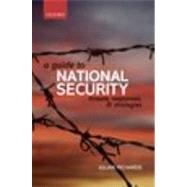
Note: Supplemental materials are not guaranteed with Rental or Used book purchases.
Purchase Benefits
What is included with this book?
| Abbreviations | p. xii |
| Threats | |
| Introduction | p. 3 |
| The 2010 National Security Strategy-breaking new ground | p. 3 |
| Priority risks and threats | p. 5 |
| National security in the UK-a modern history | p. 7 |
| Defining 'national security' | p. 14 |
| Key points | p. 17 |
| Setting the Scene: The Threat Picture in a Globalized World | p. 19 |
| 'Wider' security risks | p. 19 |
| The political backdrop | p. 20 |
| The strategic context-globalization and transnational threats | p. 25 |
| Key points | p. 30 |
| Tier One Threats | p. 32 |
| Risk and resilience | p. 32 |
| Terrorism | p. 35 |
| Cyber threats | p. 41 |
| Natural hazards and disasters | p. 44 |
| International military crisis | p. 48 |
| Key points | p. 50 |
| Tier Two Threats | p. 52 |
| Overlapping risks and capabilities | p. 52 |
| An attack using 'unconventional' weapons | p. 53 |
| Unstable and failed states | p. 56 |
| Organized crime | p. 60 |
| Disruption to satellite communications | p. 64 |
| Key points | p. 66 |
| Tier Three Risks | p. 67 |
| Backdrop-security in Europe | p. 67 |
| Wider regional conflict | p. 70 |
| Energy security | p. 72 |
| The risk of a nuclear emergency | p. 76 |
| Border security | p. 78 |
| Key points | p. 80 |
| Responses | |
| Responses | p. 83 |
| The response framework | p. 83 |
| Administrative organization | p. 86 |
| Response capability-an 'adaptable posture' | p. 90 |
| National security 'tasks' | p. 91 |
| Key points | p. 96 |
| Strategies | |
| Administering National Security: Governmental Strategies and Structures | p. 101 |
| The political origins of the National Security Council | p. 101 |
| Why an NSC? | p. 103 |
| Presidentialization and prime ministerialism | p. 106 |
| NSC process and machinery | p. 109 |
| Departmental organization outside the Cabinet Office | p. 111 |
| Key points | p. 115 |
| Boots on the Ground: Restructuring Military Capability | p. 116 |
| Introduction: the case for restructuring | p. 116 |
| Britain's place in the world | p. 117 |
| The changing character of conflict | p. 119 |
| Inter-service issues | p. 121 |
| Proposed restructuring | p. 123 |
| The nuclear question | p. 126 |
| Key points | p. 128 |
| Fighting Asymmetric Conflicts | p. 129 |
| The challenge of Afghanistan | p. 129 |
| Selling the strategy-the battle of the narratives | p. 130 |
| Peacekeeping, peace-enforcement, and counter-insurgency | p. 133 |
| Future force requirements | p. 137 |
| Key points | p. 139 |
| Domestic Policies: Counter-Radicalization and Counter-Terrorism | p. 140 |
| Old and new threats | p. 140 |
| The evolving nature of the terrorist threat | p. 141 |
| Counter-terrorism strategy in the UK | p. 143 |
| Prevent | p. 147 |
| Key points | p. 151 |
| Partnerships: EU, UN, NATO, and the 'Special Relationship' | p. 153 |
| Chance encounters and shifting alliances | p. 153 |
| The 'special relationship' | p. 154 |
| Existing alliances | p. 156 |
| Europe, and France | p. 161 |
| Counter-terrorism | p. 163 |
| Key points | p. 166 |
| Conclusions | p. 167 |
| Key points | p. 176 |
| Index | p. 177 |
| Table of Contents provided by Ingram. All Rights Reserved. |
The New copy of this book will include any supplemental materials advertised. Please check the title of the book to determine if it should include any access cards, study guides, lab manuals, CDs, etc.
The Used, Rental and eBook copies of this book are not guaranteed to include any supplemental materials. Typically, only the book itself is included. This is true even if the title states it includes any access cards, study guides, lab manuals, CDs, etc.